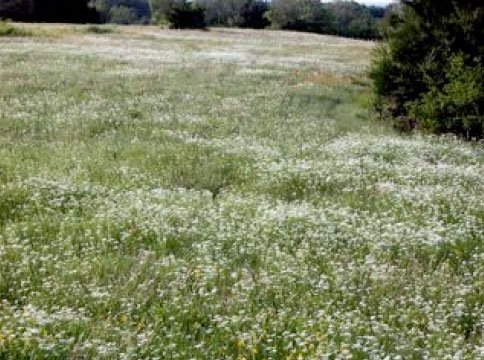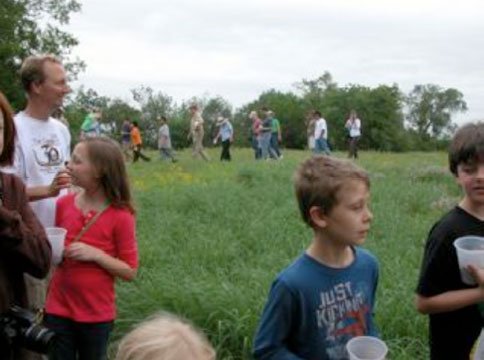prairie notes #29: The Wild Flora & fauna of Tandy Hills
Prairie Notes are monthly photo/journal observations from Tandy Hills Natural Area by Founder/Director, Don Young. They include field reports, flora and fauna sightings, and more, mixed with a scoop of dry humor and a bit of philosophy. They are available free to all who get on the FOTHNA email list.
The Wild Flora & Fauna of Tandy Hills
Prairie Notes #29
May 16, 2009
1) Surrendering to Prairie Bishop's Weed
2) Prairieland Wildflower Ball Report
3) Powderpuffs & Beethoven's Ninth (Redux)
4) THNA Rarities
5) Peter Rabbit's Descendants Pay a Visit
6) An Important Message from Jarid Manos
1) Surrendering to Prairie Bishop's Weed
It seems like every year at THNA a different plant species tends to grab the spotlight. This year that species is Prairie Bishop's Weed (Bifora americana). Like an Earthbound Milky Way or dreamy banks of Texas clouds, PBW meanders gracefully through Tandy Hills, adding harmony to the showy wildflowers. In the slightest breeze it becomes a swirling, foaming sea of tranquility making it irresistible to Eastern Black Swallowtail butterflies and vulnerable humans.
Don't confuse PBW with a vaguely similar but more leathery, roadside invasive, this native is as delicate as a silk blouse, its slight stems supporting umbels of weddingwhite flowers and filigree foliage, not unlike dill weed. But there is power in numbers and Prairie Bishop's Weed is innumerable at THNA this year.
2) Prairieland Wildflower Ball Report
Not even rain and wind could stop the ultimate mission of FOTHNA from taking place on a blustery, May 9th, 2009, when over 30 people participated in the first ever, Prairieland Wildflower Ball. "Prairieland" is the new name of the family/kids area at Prairie Fest, masterfully conceived and organized by Jan Upchurch. In cooperation with the Botanical Research Institute of Texas (BRIT) and under the guidance of Kathy Scott, dozens of kids made seed-balls out of mud and a special mix of wildflower seeds selected by FW Nature Center & Refuge director, Suzanne Tuttle.
Last Saturday, an excited bunch of kids and their parents listened patiently to Kathy explain how special THNA is and how their work making seed-balls would benefit the prairie. With Olive the Prairie Dog leading the way, hundreds of seed-balls were distributed throughout an area cleared at this years Brush Bash. We look forward to making this event an annual tradition. See more pics of the event on the FOTHNA website, soon.
3) Powderpuffs & Beethoven's Ninth (Redux)
Metaphor Madness: If Tandy Hills Natural Area is a "concert in the park" and the current crop of wildflowers is "Beethoven's Ninth Symphony with full chorus," then, Powderpuffs are the "show-stopper fireworks" that make the crowd ooooo and ahhhh during the finale. Also known as, Sensitive Brier, (Mimosa roemeriana), when you gently touch the foliage you'll see why they are so sensitive.
The merry month of May is indeed the most explosive month for wildflowers at THNA, including Powderpuff. Here's my list of what's currently on the star-studded program, and I always miss a few:
01) Bluets (Stenaria nigricans)
02) Indian Blanket (Gaillardia pulchella)
03) Foxglove (Penstemon cobaea)
04) Wild Hyacinth (Camassia scilloides)
05) Meadow (Blue) Flax (Linum pratense)
06) Yellow Flax (Linum rigidum)
07) Standing Winecup (Callirhoe pedata)
08) Stork's Bill (Erodium texanum)
09) Skullcap (Scutellaria drummondii)
10) Texas Sage (Salvia texana)
11) Sensitive Brier (Mimosa roemeriana)
12) Blue-eyed Grass (Sisyrinchium chilense)
13) Texas Vervain (Verbena Halei)
14) Prairie Bishop's-Weed (Bifora americana)
15) Purple Cone-Flower (Echinacea angustifolia)
16) Barbara's Buttons (Marshallia caespitosa)
17) Crameria (Krameria lanceollata)
18) Engelmann Sage (Salvia engelmannii)
19) Engelmann (Cutleaf) Daisy (Engelmannia peristenia)
20) Yellow Sundrops (Calylophus serrulatus)
21) Texas Star (Lindheimera texana)
22) Old Plainsman (Hymenopappus scabiosaeus)
23) Greenthread (Thelesperma filifolium)
24) Prairie Paintbrush (Castilleja purpurea)
25) Antelope Horns Milkweed (Ascelpias asperula)
26) Fluttermill, Missouri Primrose (Oenothera macrocarpa)
27) Scarlet Gaura (Gaura coccinea)
28) White Milkwort (Polygala alba)
29) Prairie (Indian) Plantain (Arnoglossum plantagineum)
30) Two-leaved Senna (Senna roemeriana)
31) Yucca (Yucca sp.)
32) Queen's Delight, (Stillingia texana)
33) Prairie Brazoria, (Warnockia scutellarioides)
34) Prairie Fleabane (Erigeron modestus)
35) Prairie Larkspur (Delphinum carolinianum)
36) Prairie Parsley (Polytaenia nuttallii)
37) White Rosinweed (Silphium albiflorum)
38) Mock Pennyroyal (Hedeoma reverchonii)
4) THNA Rarities
Rain changes things: Two of the rarest species at THNA are now blooming or soon will. In August, 2007 I reported on the Purple Leatherflower (Clematis Pitcheri) I discovered on the far north central trail. As far as I know, there are only two such plants at THNA. Due to the drought, they did not even form leaves in 2008, but blooms are on the vine again this year. Keep a sharp eye out and you can get a closer look at this rare beauty.
Although THNA has an abundance of the iconic, Purple Prairie Paintbrush, I have observed only a single specimen of Texas Paintbrush (Castilleja indivisa). It is now blooming along one of the north easterly trails. Both of these rare plants should be treated with extra care.
5) Peter Rabbit's Descendants Pay a Visit
Living near THNA has many rewards, one of which is the opportunity to view a variety of wildlife up close. Even though we are only 5 minutes from downtown, we get visits from wild turkeys, roadrunners, coyotes, raccoons and a few other birds and mammals.
Now we can add rabbits to the list. One evening last week I spotted a small cottontail, just across the street, chewing on prairie grass. The next day, a couple of baby rabbits (known as kits, not bunnies) scattered from the bushes when I switched on my electric lawn mower. Looking for shelter, one of them ended up on the porch where I retrieved it for a photo-op, as you can see below. Apparently, our front yard is their back yard.
--- A few years ago, in an effort to live more in tune with nature, Debora and I decided to begin the process of helping our front yard return to its natural state, as a prairie. We applied for and received certification from the National Wildlife Federation as a wildlife habitat. I guess the rabbits finally got wind of it.
Drive carefully out there.
6) An Important Message from Jarid Manos
An important and time-sensitive message from Jarid Manos of Great Plains Restoration Council:
Dear Everybody,
We have received a generous donation covering the cost of native seed to restore the pipeline cut on the Fort Worth Prairie Park out in southwest Fort Worth.
VOUNTEER WORK CREWS ARE FORMING RIGHT NOW. Please join in! We need to get the seed in the ground preferably by the end of June, and there are a couple of miles to do. This Prairie Restoration job basically involves rake work, reseeding, and the slight covering of sown seed. It is good, healthy, rewarding work that helps protect the integrity of our endangered 2,000 acre Prairie Park, and a lot of fun too because it allows a deeper and less passive experience of wild nature.
SIGN UP
Please call Great Plains Restoration Council at 817 838 9022; email is info@gprc.org.
Please volunteer today. We will keep on going out there until the job is done. If you have extra tools, please bring them.
Thank you for caring about the globally rare Fort Worth Prairie ecosystem. We must save what's left now before this ecosystem becomes functionally extinct.
----the staff and youth of Great Plains Restoration Council
www.gprc.org
Here is a recent Star-Telegram article by Bob Ray Sanders on the Prairie Park work:
http://www.startelegram.com/news/columnists/bob_ray_sanders/story/131155...
DY
Come to the meadow - soon - and surrender to the healing power of Prairie Bishop's Weed on your mind and body.











